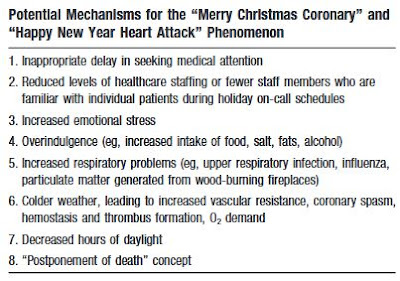#12,974
Ask just about any paramedic, ER nurse or doctor and they will tell you that the Holidays - from around Thanksgiving to just after New Year's Day - see a spike in sudden coronary attacks. Events that are commonly called `Christmas Coronaries’ or `Hanukkah Heart Attacks’.
Eighteen years ago, a study looked at the rate of heart attacks in the United States, and found that Acute Myocardial Infarctions (AMIs) run as much 53% higher during the winter months than than during the summer.
Seasonal distribution of acute myocardial infarction in the second National Registry of Myocardial Infarction.
Spencer FA, Goldberg RJ, Becker RC, Gore JM.
While cold weather combined with strenuous physical activity (like clearing snow from sidewalks) has often been blamed for this spike, even in balmy Southern California, studies have shown a 33% increase in heart attacks over the holidays (see below).
When Throughout the Year Is Coronary Death Most Likely to Occur?
A 12-Year Population-Based Analysis of More Than 220 000 Cases
Robert A. Kloner, MD, PhD; W. Kenneth Poole, PhD; Rebecca L. Perritt, MS
Non-climate related factors – like over indulgence in food and alcohol, diminished activity levels, forgetting to take prescription medicines, and combined holiday stressors like shopping, running up debt, traveling, meal preparation, and the angst that comes from dysfunctional family gatherings are likely contributors to this yearly spike.
In his 2004 article in Circulation The ''Merry Christmas Coronary'' and ''Happy New Year Heart Attack'' Phenomenon, Dr Robert Kloner posited the following reasons for this uptick in excess winter cardiac mortality.
While all are likely contributors, in recent years influenza and other respiratory infections have been increasingly linked to this seasonal increase in heart attacks.
Earlier this year, in Int. Med. J.: Triggering Of Acute M.I. By Respiratory Infection we looked at research from the University of Sydney that found the risk of a heart attack is increased 17-fold in the week following a respiratory infection such as influenza or pneumonia.
A little over two years ago, in UNSW: Flu Vaccine Provides Significant Protection Against Heart Attacks, we saw a study that found that if you are over 50 - getting the flu vaccine can cut your risk of a heart attack by up to 45%.Going back even further:
- In August of 2013 (see Study: Flu Vaccine May Reduce Heart Attack Risk), we looked at study out of Australia – published in the BMJ Journal Heart, that found compelling – but not exactly conclusive – evidence that flu shots may reduce the risk of heart attacks as much as 45%.
- In October of 2013 (see JAMA: Flu Vaccine and Cardiovascular Outcomes) we looked at a meta analysis that found among patients who had previously had a heart attack, the receipt of a flu vaccine was linked to a 55% reduction in having another major cardiac event in the next few months.
- In 2012, in Study: Influenza And Heart Attacks, we looked at research that appeared in the Journal of Infectious Diseases that suggested Influenza - and other acute respiratory infections - can act as a trigger for heart attacks. The same issue carried an editorial called Increasing Evidence That Influenza Is a Trigger for Cardiovascular Disease.
Given the expected reduced effectiveness of this year’s flu vaccine ((see ECDC: H3N2 Flu Vaccine Component Likely `Suboptimal',) and the rising tide of H3N2 influenza across the country – the next couple of weeks could prove very busy for the nation’s EMS crews and Coronary care units.
But regardless of the effectiveness of this year’s flu shot, and influenza’s effects on cardiovascular events, even on an `average day’ roughly 1,000 people suffer a Sudden Cardiac Arrest (SCA) in the United States.This from the Heart Rhythm Association:
- Sudden Cardiac Arrest (SCA) is a leading cause of death in the United States, claiming more than 350,000 lives each year.
- Approximately 92% of those who experience sudden cardiac arrest do not survive.
- SCA kills more than 1,000 people a day, or one person every 90 seconds
With a few hours of training, you have the potential to save someone’s life. To find a local CPR course contact your local chapter of the American Red Cross, the American Heart Association, or (usually) your local fire department or EMS can steer you to a class.
To learn how to use an AED, you can use this online training module I wrote about in CPR Skills & AED Simulator.Of course, despite your best efforts, many SCA victims will not survive. It isn’t at all like on TV, where 75% of recipients of CPR survive. Even when cardiac arrests occur inside a hospital, the survival to discharge rate is less than 40%. Outside the hospital, the odds of seeing a good outcome are lower.
While there are no guarantee of success, early and coordinated action taken by bystanders (calling 911, starting CPR, using AED if available) can substantially improve the SCA’s chances of survival.
Obviously, the best way to survive a heart attack is not to have one to begin with.Which is why I continue to promote getting the seasonal flu shot every year, and practicing good flu hygiene (covering your coughs, washing your hands, staying home when you are sick, etc.) - because, while far from perfect - these steps do reduce your odds of getting sick from the flu.
Because, when it comes to something as serious as a heart attack, every little advantage helps.

